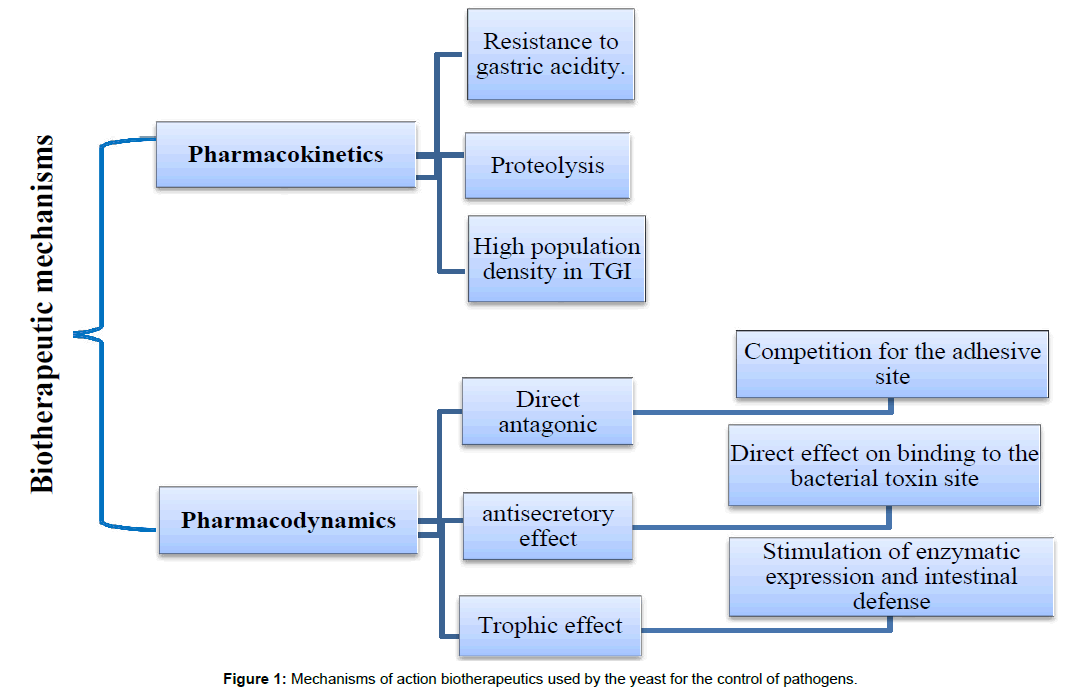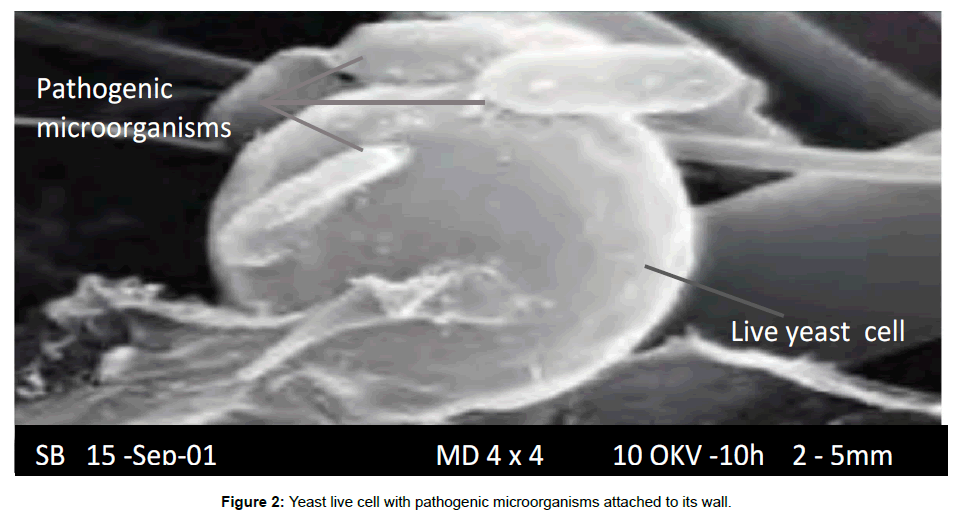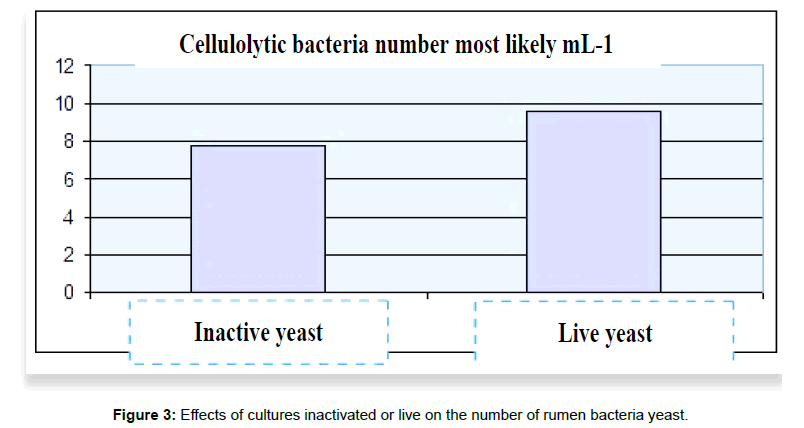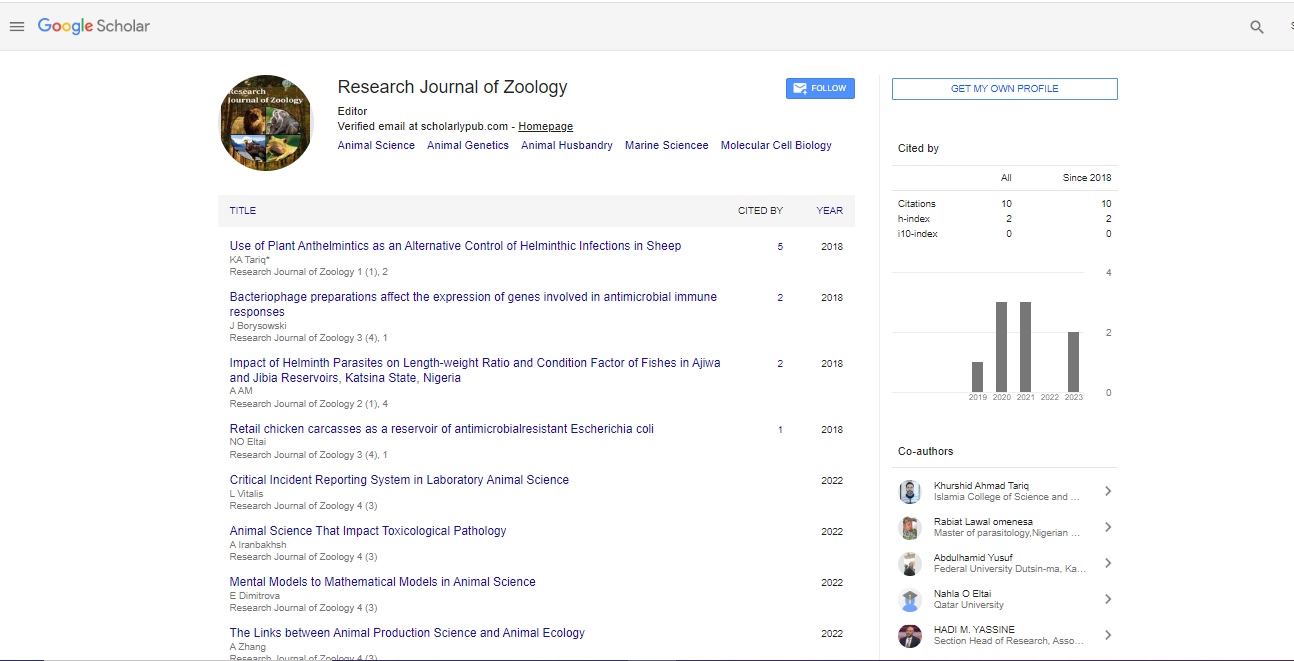Review Article, Res J Zool Vol: 1 Issue: 1
Probiotic Use of Yeast Saccharomyces Cerevisiae in Animal Feed
Caridad Suarez* and Guevara CA
Cuban researches Institute of Sugar Cane Derivatives (ICIDCA). Avenue White 804, Corner Central Road, San Miguel del Padron, Havana, Cuba
*Corresponding Author : Caridad Suarez
Cuban researches Institute of Sugar Cane Derivatives (ICIDCA). Avenue White 804, Corner Central Road, San Miguel del Padron, Havana, Cuba
Tel: (202)296-4810
E-mail: caridad.suarez@icidca.azcuba.cu
Received: December 18, 2017 Accepted: January 08, 2018 Published: January 15, 2018
Citation: Suarez C, GuevaraCA (2018) Probiotic Use of Yeast Saccharomyces Cerevisiae in Animal Feed. Res J Zool 1:1.
Abstract
With this work we emphasize the importance of probiotic use of yeast Saccharomyces cerevisiae in animal feed, because in our country, usually is used only as a protein source, so it resorts to a review of the probiotic effect of this yeast, describing its mechanism of action; as well as, the effect on the productive and health indicators in the animals. Concluding that the probiotic use of yeast Saccharomyces cerevisiae is an option to consider if you want to efficiently feed the animals, making improvements in production and health res indicated, thanks to the protein content of this yeast and its probiotic effect when they are used alive
Keywords: Probiotic; Saccharomyces cerevisiae; Feed; Effect
Introduction
Although the scientific interest for probiotic additives began in 1950, in recent years, it has increased by optimizing the use of additives or novel ingredients arising from biotechnological processes, which has led to the application of living organisms and / or the products of their metabolism in increasingly diverse sectors of production.
One of the lines is impacted animal production, specifically oriented to animal nutrition, emerging non-antibiotic options including: enzymes, yeasts and live bacteria and metabolites thereof, or complex sugars pathways that act as immunomodulatory and they are known generically as probiotics.
Product development with probiotic characteristics as part of the diet leads to an improvement in the efficiency of feed utilization, improving production indicators and reducing the incidence of diarrheal diseases and mortality in animals. With this work we aimed to highlight the importance of using probiotic yeast Saccharomyces cerevisiae in animal feed.
Probiotics
Probiotics have been defined by Tellez [1] as living microorganisms contained in the feed of animals positively affect the host by improving its digestive system; on the other hand Simon et al. [2], defined probiotics as viable microorganisms that increase the weight gain and conversion ranges feed and reduce the incidence of diarrheas.
Probiotics are one of the most exploited proposals when it comes to production systems ensure efficient and safe to consumers and the environment Brown [3].
Zimmermann et al. [4], they ensured that probiotic supplementation has been recommended for the treatment or prevention of various diseases and stress conditions of a number of species.
Saccharomyces cerevisiae yeast
Yeasts are an important source for obtaining products with probiotic activity, either as live strains or using derivatives from their cell walls. These preparations have shown a proven immunostimulatory activity in farm animals as well as improvements in the processes of the digestive physiology, contributing to better production results Morales [5].
Kumura et al., Campeanuet al., Bovill et al. and Coenen [6-9], agree in saying that strains more informed in their use as probiotic yeast belonging to the genera Saccharomyces, Kluyveromyces, Hansenula, Pichia and Candida and within these genera, species S. boulardii, S. cerevisiae, K. fragilis, K. lactis, C. saitoana and C. pintolopesii.
It is important to note that the selection of the probiotic strain, depends on the requirements of the animal that will be delivered, should ensure the diversity of biota in the intestine and provide stability to their ecology, which can be affected by changes diet, stress and strenuous exercise Amaral [10].
Perez [11] states that the most important selection criteria that have been used to select yeast strains with probiotic properties are grouped by their strength properties, functions and potentials, highlighting among these:
• Tolerance to high acidity.
• Resistance to bile salts.
• Adhesion capacity to intestinal cells.
• Direct antagonistic effect on enterobacteria and other yeasts.
• Antisecretory effect against the toxins of pathogenic microorganisms.
• Trophic effect on the mucosa through the production of polyamines.
• Immunostimulant effect.
Doleza et al. [12], they asserted that S. cerevisiae yeast is used as ruminant feed supplement; in which, you can improve the rumen environment, due to the decreased amount of oxygen, favoring anaerobiosis and stimulating growth of bacteria cellulolytic or as, Hirstov et al. [13] by reducing the concentration of ammonium and increase the synthesis of microbial protein.
In Cuba, specialists from the Institutes of Animal Science (ICA), the Cuban Research Institute of the Sugar Cane Derivatives (ICIDCA) and the University ‘’ Camilo Cienfuegos ‘’ of Matanzas, developed a group of products with probiotic characteristics (Provicid, Prolev), where they obtained promising results in production and animal health indicators corresponding to the points made by Brizuela, Bocourt et al, Garcia et al and Piad [14-17].
Garcia et al. [18] showed that the use of yeast in feeding dairy cow impact favorably on levels of production and quality of milk through a series of improvements that occur in the rumen environment. The addition of this probiotic increases the number of cellulolytic bacteria in the rumen; the ingestion of dry matter, the ammonium production is stimulated, the proteolysis is reinforced, the digestion and absorption of nutrients improves and the digestion of the fiber contained in the food increases, which results in an increase of the average milk production of 1.13 kilograms per cow per day (Kg/ cow/d).
Yeasts are not usual hosts of digestive microbial biota in monogastrics animals; therefore, S. cerevisiae flows along the digestive tract as alive and active without adhering to the walls thereof. Strains that have no ability to adhere to intestinal epithelia are effective as bio regulators and their action depends on ability of colonization through several mechanisms Rodríguez, et al and Baptista [19,20] refer in its work, the use of live yeast cells as agents to detoxify mycotoxins and other bacterial toxins such as secreted by C. difficile and its receptors in the colonic mucosa and Vibrio cholera toxin. Severe organ damage due to diets that may contain these toxins was eliminated in the presence of S. cerevisiae for its ability to reduce animal stress, providing vitamins, enzymes and proteins Baptista et al. [21].
According Delgado et al. [22], the use S. cerevisiae as nutritional additive, has a probiotic effect that helps reduce the incidence of diarrhea and, when produced, its duration decreases. The additives based on yeast or yeast culture act at the ruminal level influencing the fermentation in the following parameters:
• Production of volatile fatty acids
• Reduction of methane production
• Decreased ammonia concentration
• They favor the stability of the pH.
• Increased activity of the cellulolytic Flora
• Increase in total anaerobic flora
• They favor the flora that derives lactate to propionic
The use of probiotics in the case of yeast is given by their bioregulatory action, which occurs by various mechanisms between which are generally: microbial antagonism suppression of pathogenic bacteria, stimulating the immune system of the animal, attachment and removal of pathogens and increased activity specific enzyme bacteria. Perez [23], also referred to from the point of view biotherapeutic these mechanisms can be classified as pharmacokinetic and pharmacodynamics, as shown in the following Figure 1.
How to use yeasts
Using the yeast S. cerevisiae as a supplement in feed for ruminants, it has proved positive by Lezcano et al. [24], since the amount of food eaten results in weight gain, as well as increasing productivity and milk quality.
There are products based on dried live yeast where it is sought to obtain a concentration of living cells as high as possible, standing out how the most usual concentrations in the order of 108 -1010 colony forming units per gram (CFU/g)
Dried yeast cultures are alternative products that do not provide live yeast, but fermentation products of said yeast on a vegetable medium. These enzymes provide yeast cultures, and other metabolites (amino acids and vitamins) which seem to be really producing positive effects when subsequently administered to the animal.
It has been described as an alternative, the use of live yeasts both in monogastric animals as in ruminants and more specifically in calves, and small ruminants. Irianto et al, Nikoskelainen S and Yuste C [25-27], states that the use of aerobic metabolically active yeasts is imposed on dry-active yeasts, which, on the other hand, must be revived when arriving at the rumen, a process that requires special conditions of:
• Humidity
• Temperature
• Nutrients
This forces us to take into account the adaptation time (“lag”) to the environmental conditions from its latent state to full activity, whose duration is very variable and can last up to one hour.
Suárez et al. [28] stated that in Cuba, currently the recovery of yeast is only as a secondary product of the distilleries and it is considered that due to the nutritional importance of this product, it is necessary to implement technologies that improve the composition of the yeast and power expand its use profile.
Live yeasts of zootechnical use are possibly the group of microorganisms that has been studied the most and that have had the greatest reception during the last two decades in bovine production, due to the probiotic effect they have on the animal.
The mode of action of yeast for animal use has three basic principles:
• Activity respiratory yeast (exclusive of living organisms) which consume the oxygen present in the rumen and reduces its negative effect on the population of strictly anaerobic microorganisms.
It has been shown by Carro et al and Newbold [29,30] that by adding live yeast to ruminal fluid (in vitro), the presence of oxygen is reduced between 46 and 89%. This generates an increase in the population of total microorganisms of the rumen close to 30% Newbold et al. [31], which leads to a better use of food, causing an increase in the production of energy Carro [29] and microbial protein that ranges between 10 and 20%.
Furthermore, the use of live yeast selectively stimulates the growth of bacteria populations consuming lactate (Megaspharera elsdenii and Selenomonas ruminantium) which reduces the presence of lactic acid, thereby avoiding steep drops ruminal pH. This is because yeast competes for the consumption of sugar with lactate-producing bacteria and stimulates the growth of lactate-using bacteria, which decreases the incidence of acidosis and therefore digestive problems, lameness and high somatic cell counts associated with this cause Marrero [32].
• In various scientific studies, as Elias et al, Castillo, Galina et al and Sosa et al. [33-37] has shown that the presence of live yeast in the digestive system of animals causes a phenomenon called competitive exclusion, in which certain bacteria capable of causing disease adhere to the surface of the yeast, and so removing a significant amount of harmful microorganisms and allowing the Animal defend more effectively Alvarado [38] (Figure 2).
• The third mechanism occurs due to beta - glucan, found in the outer wall of yeast, whose function is to stimulate the natural defense system of the body, allowing when a threat to health animals occurs, this responds quickly and efficiently. Therefore healthier and productive herds are obtained, coinciding with the point made by Delia et al and valeriano et al. [39,40], which ensure that there is evidence that probiotics can stimulate specific immune response and unspecific
The residues produced in the alcohol and brewery industry are known as brewery yeasts, they are excellent sources of protein, however, without activity as an additive, since the yeast cells they possess are, for the most part, dead. In the same way, the additives that have inactive yeast cells have no activity in the rumen, being only a source of nutrients for the microorganisms of the gastrointestinal tract.
Research by kould, were cited by Dawson and Valinote [41,42], show that the additives action in the rumen is those with live cells (Figure 3).
Huber [43], on research conducted on the effects of this yeast in animals, says that 74% of recent publications show positive results versus 22% negative. And it recognizes as an average value of improvement in milk production, 3.6% (equivalent to 1 liter/day) when yeasts were used, metabolically active, in the diet, in addition to referring an increase of 2.5% of ingestion of dry matter, equivalent to 0.46 kg / day of extra ingestion.
Alvarado [38] showed that the direct result of the use of yeast Saccharomyces cerevisiae is increased milk production and / or meat between 5 and 8%.
In studies conducted by Gilliard [44] with a commercial cocktail containing: yeast culture, fermentation extract of Aspergillus oryzae, Lactobacillus acidophilus, Bacillus subtilis, enzymes (α-amylase, β- glucanases, hemicellulases and cellulases), to 3417 animals, 46 herds over a period of milk production between 60 and 365 days, the results shown in the following were obtained (Table 1).
| Heifers | Cows | Total | |
|---|---|---|---|
| Production milk (kg / day) Grease Protein |
+0,73 - - |
+0.56 - - |
+0.64 - - |
| Fat content (%) Protein content (%) |
- - |
- - |
-0.1 - |
Table 1: Effect of supplementation with an additive based on fermentation extracts and yeast culture, probiotics and enzymes on production and milk quality.
All this evidence, that although there variability in the results, the use of yeast Saccharomyces cerevisiae as probiotic, generally offers positive results in animal health and their productivity.
In summary, the use of live yeast in ruminants is associated with improvements in productive expression:
• Stabilizes the pH in the rumen, due to the increase of cellulolytic bacteria and other bacteria that use lactic acid, achieving greater efficiency in the digestive process and preventing acidosis
• Increases dry matter consumption and fiber degradation. This is because l to greater fiber digestion leads to increase the speed of passage through the rumen, allowing the animal to consume more feed, live yeast also increases the number of Selenomonas ruminantium in the rumen.
• Increases energy production and microbial protein in the rumen
• Increase milk production.
• It favorably influences the average daily gain of live weight and improves body condition.
• It reduces the somatic cell count in milk and helps to stabilize its quality.
• Stimulates the non-specific immune response of animals
Recommended doses in animal feed
Cream yeast Saccharomyces cerevisiae, has been used in animal feed in different proportions as part of the diet, 10% in cattle, sheep and 5% in the birds between 3 and 4% which also ensures that when the distilled must is demineralized; you can duplicate this contribution in diet composition.
According to Marrero and Valdebenito et al. [32,45], live yeast S. cerevisiae is recommended for animal feed at a dose of 1 g per 100 kg and its Dawson [46] part, he says it is essential that remain metabolically active yeast to make it functional and stimulate growth and bacterial activity to degrade fiber and increase the production of organic acids (acetic, propionic and lactic)
Everything referred to in this article shows a coincidence with what was raised by Suarez et al. [47] When referring that today, the goal of animal production is to provide safe and quality food for human consumption, prioritizing the welfare of animals, respect for the environment and consumer safety, as it is widely known risk of contamination with pathogenic microorganisms in foods of animal origin and, on the other hand, the development of antibiosistance of certain pathogens, due to the use of antibiotics for probiotic purposes.
Conclusions
• Saccharomyces cerevisiae yeast is undoubtedly an important alternative if we consider animal feed efficiently as it improves production and health indicators.
• The use of live yeast in animals is an excellent option, taking into account its probiotic nature and therefore its incidence in the maintenance of health in animals.
References
- Tellez G (2008) Prebiotics, probiotics and symbiotic, its role on gut integrity. Av Tec By 5.
- Simon O, Jadamus A, Vahjen W (2001) Probiotic feed additives- effectiveness and expected modes of action J Anim Feed Sci 10: 51-67.
- Brown M (2011) Modes of Action of Probiotics: Recent Developments. Anim Vet Adv 10: 1895-1900.
- Zimmermann B, Bauer E, Mosenthin R (2001) Probiotics and prebiotics in pig nutrition potential modulators of gut health? J Anim Feed Sci 10: 47-56.
- Morales JL (2004) Application of a probiotic supplement in the recovery of a layer replacement. Fourth Congress of Aviculture, Santiago de Cuba.
- Kumura H, Tanoue Y, Tsukahara M, Tanaka T, Shimazaki K (2004) Screening of yeast strains for probiotic applications. J Dairy Sci 87: 4050-4056.
- Campeanu GH (2002) Biotechnological studies Obtaining Concerning the role of biomass with probiotic yeasts and bacteria form. Roum Biotechnol Lett 7: 795-802.
- Bovill R, Bew J, Robinson S (2001) Comparison of selective media for the recovery and enumeration of probiotic yeasts for animal feed. Int J Food Microbiol 67: 55-61.
- Coenen TM (2000) Safety evaluation of enzyme preparation derived from lactate Kluyveromyces lactis. Food Chem Toxicol 38: 671-677.
- Amaral C (2006) The analysis of patents, tool for determining lines of research on probiotics in Cuba. The Master's Scientific Degree, University of Havana.
- Perez H (2007) Evaluation and selection of strains of yeasts with probiotic characteristics for use as a food additive. The Academic Title of Master in Microbiological Sciences mention in Fermentations, Havana.
- Doleza P, Dvoracek J, Dolezal J, Cermakova J, Zeman R, et al. (2011) Effect of feeding yeast culture on ruminal fermentation and blood indicators of Holstein dairy cows. Acta Vet Brno 80: 139-145.
- Hirstov AN, Varga G, Cassidy T, Long M, Heyler K, et al. (2005) Effect of Saccharomyces cerevisiae on ruminal fermentation product fermentation and nutrient utilization in dairy cows. J Dairy Sci 93: 682-692.
- Brizuela MA (2003) Selection of strains of lactic acid bacteria to obtain a preparation with probiotic properties and its evaluation in pigs. The degree of Doctor in Veterinary Sciences, Cuban Institute of Derivatives of the Sugar Cane.
- Bocourt R, Savón L, Brizuela MA, Serrano P, Prats A, et al. (2004) Effect of the probiotic Lactobacillus rhamnosus on activity of productive and health indicators of piglets. Cuban J Agricul Sci 38: 75.
- Garcia M, Lopez Y (2002) Carcasses A Use of Probiotics in Animals. Argentine Site of Animal Production.
- Piad RE (2001)Evaluation of the probiotic activity of an enzymatic distiller cream hydrolyzate in layer replacement chicks. The Scientific Degree of Doctor in Veterinary Sciences Institute of Animal Science, Agrarian University, Havana.
- Garcia M (2012) Carcasses A Use of Probiotics in Animals. Argentine Site of Animal Production.
- Rodrigues AC, Cara DC, Fretez SH, Cunha FQ, Vieira EC, et al. (2000) Saccharomyces boulardii stimulates sIgA production and the phagocytic system of gnotobiotic mice. J Appl Microbiol. 89: 404-414.
- Baptista AS (2002) Utilization of thermalized and active yeast to reduce the toxicity of aflatoxin. Scientia Agric 59: 257-260.
- Baptista AS, Horii J, Stefano SM (2005) Cells of yeasts adhered in corn grains and the storage perspective for use as probiotic. Braz Arch Biol Technol 48: 15-20.
- Delgado R, Barreto G, Vazquez (2015) Saccharomyces cerevisiae R. Employment for the prevention and control of diarrhea in calves grazing. Rev Prod Anim 27.
- Perez H (2007) Evaluation and selection of strains of yeasts with probiotic characteristics for use as a food additive. The Academic Title of Master in Microbiological Sciences Mention in Fermentations, Havana.
- Lezcano P and Mora LM (2005) The vinasse of alcohol distillery. Environmental contamination or treatment to avoid it. In: Eighth Meeting of Nutrition and Production of Monogastric Animals, Guanare, Brazil.
- Irianto A, Austin B (2002) Review probiotics in aquaculture. J FishDis 25: 633-642.
- Nikoskelainen S (2001) Characterization of the properties of Human- and dairy-derived probiotics for prevention of infectious diseases in fish. Appl. and Environ. Microbiol. 67: 2430-2435.
- Yuste C (2017) Efficacy of yeast active cultures in improving digestibility. Nutritional information.
- Suarez C, Garrido NA, Guevara CA (2016) The yeast Saccharomyces cerevisiae and the production alcohol. Cuban researches Institute of Sugar Cane Derivatives (ICIDCA) Cuba
- Carro MD, Saro C, Mateos I, Díaz A, Ranilla MJ (2015) Use of probiotics in the feeding of ruminants. Department of Animal Production, Polytechnic University of Madrid, Spain.
- Newbold CJ (1996) Manipulating the Rumen: A close looks functional additives in Biotechnology in the animal feed industry. Mexico Apligen 4: 41-53.
- Newbold CJ, Mc Intosh FM, Wallace RJ (1998) Changes in the microbial population of a rumen simulating fermenter in response to yeast culture. Ani J Sci 78: 241-244.
- Marrero Y (2005) Yeasts as enhancers of ruminal fermentation of diets with high fiber content. Thesis, Institute of Animal Science, Havana, Cuba.
- Elías A, Herrera FR (2009) Production of animal feed through simple biotechnological processes with the use of activated beneficial microorganisms (MEBA). Institute of Animal Science, Havana, Cuba.
- Castillo CY (2009) Fermentation in vitro for the yeast Candida norvengensis in a mixture of alfalfa with fermented apple bagasse and its effects on ruminal microbial activity. Dr. Autonomous University of Chihuahua, Mexico.
- Galina M, Pineda LJ, Morales R (2010) Supplementation in dairy goat grazing with a slow nitrogen release source (SLNN), with or without the addition of a lactic acid probiotic. Third Congress of Tropical Animal Production and First FOCAL Symposium, Havana, Cuba.
- Galina M, Pineda LJ, Hummel OJ, Ortiz R (2010) Effect of probiotic use in ruminal lactic fermentation goats developing. Third Congress of Tropical Animal Production and First FOCAL Symposium, Havana, Cuba.
- Sosa A, Galindo J, Bocourt R, Rodriguez R, Albelo N, et al. (2010) Effect of Aspergillus oryzae on the rumen fermentation of Pennisetum purpureum cv. Cuba CT-115 in vitro through the gas technique. Cuban J Agric Sci 44: 151.
- Alvarado E (2011) Benefits of the use of yeasts in ruminants Myth or reality? Lesaffre Feed Additives, Heredia, Costa Rica.
- Delia E, Tafaj M, Frauen K (2012) Probiotics in Efficiency of Farm Animals in: Probiotic in Animals.
- Valeriano MP, Balolong DK (2017) Probiotic roles of Lactobacillus sp. in swine: insights from gut microbiota.122: 554-567.
- Dawson KA (1992) Current and future role of yeast culture in animal production: A review of research over the last Seven Years in E. Lyons Ed Biotechnology in the Feed Industry, Proceedings of Alltech's Ninth Annual Symposium. Nicholasville, KY.
- Valinote AC (2011) Using yeast cultures in animal nutrition. Argentine site of Animal Production, Alltech Brazil.
- Huber T (1998) Yeast products help cows handle heat. Hoard's Dairyman. University of Arizona, USA.
- Gilliard ML (1997) Linear trend in lactation past 60 days to evaluate the supplementation in a multi-herd field trial. J Dairy Sci 80: 260.
- Valdebenito Y, Escobar M, Pak N (2004) Glucans in cereals yeasts and mushrooms. Rev Chil Nutr 21: 203-253.
- Dawson KA (1993) Current and future role of yeast culture in animal production: a review of research over the last seven years. Biotechnol 9: 1-21.
- Suarez C, Guevara CA (2017) Saccharomyces cerevisiae yeast in the feeding of ruminants. Cuban Researches Institute of Sugar Cane Derivatives (ICIDCA), Cuba.
 Spanish
Spanish  Chinese
Chinese  Russian
Russian  German
German  French
French  Japanese
Japanese  Portuguese
Portuguese  Hindi
Hindi 



